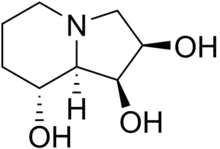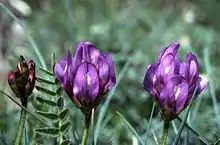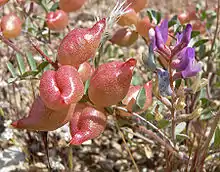Locoismus
Locoismus ist die Bezeichnung für schwere Vergiftungserscheinungen bei Weidetieren, die durch den Verzehr von Pflanzen mit dem Inhaltsstoff Swainsonin hervorgerufen werden. Der Begriff leitet sich vom spanischen loco = dt. „wahnsinnig“ ab. Locoismus tritt vor allem nach dem Verzehr von Pflanzen aus den Gattungen Astragalus und Swainsona auf. Diese Arten werden unter der Sammelbezeichnung Locoweed (engl. weed = dt. „Unkraut“) zusammengefasst.

Pflanzenarten


_(8469881299).jpg.webp)
Bisher wurde Swainsonin in folgenden Pflanzenarten nachgewiesen:[1]
- Gattung Tragant (Astragalus)
- A. earlei
- A. mollissimus
- A. pubentissimus
- A. lentigenosis
- A. pehuenches[2]
- A. wootoni
- A. nothoxys
- A. oxyphysus
- A. tephrodes
- A. humistratus
- Gattung Swainsona
- Gattung Oxytropis
- O. sericea
- O. campestris
- Außerdem in
Der unter anderem auf der Pflanze Oxytropis lambertii beheimatete Pilz Embellisia fungi macht aus der ohne den Pilz ungiftigen Pflanze durch die Produktion von Swainsonin ein Locoweed, das bei Ratten zu Vergiftungen führen kann.[8][9][10]
Wirkung bei Weidevieh
Bei Weidetieren verursachen die vor allem im Westen Nordamerikas beheimateten Locoweed-Pflanzen den so genannten Locoismus. Dies ist eine durch das in diesen Pflanzen enthaltene Swainsonin hervorgerufene neurologische Erkrankung. Der Verzehr der Pflanzen kann zu starker Abmagerung (auch bei genügender Futteraufnahme), Herzversagen, spontanem Abortus, reduzierter Fruchtbarkeit, Fehlbildungen bei Embryonen und einem Suchtverhalten für Locoweed-Pflanzen führen.[11] Die Symptome ähneln nicht zufällig denen einer α-Mannosidose, einer genetischen Erkrankung, bei der das Enzym α-Mannosidase in seiner Funktion stark eingeschränkt ist.[12][13] Swainsonin hemmt reversibel die Enzyme α-Mannosidase im Lysosom und Golgi-α-Mannosidase II von Zellen, was zu einer Akkumulation von mannosereichen Oligosacchariden im Lysosom führt.[14]
Der durch Locoweed in den westlichen Staaten der USA entstehende wirtschaftliche Schaden wird auf mindestens 100 Millionen Dollar jährlich geschätzt.[15] Andere Schätzungen gehen von noch wesentlich höheren Schadenswerten aus.[16][17]
Der Maximalgehalt von Swainsonin im Futter der Weidetiere sollte unterhalb von 0,001 % liegen, um Vergiftungserscheinungen zu vermeiden.[18] Swainsonin reichert sich im Lysosom der Zellen an.[19]
Weiterführende Literatur
- Review-Artikel
- M. H. Ralphs, J. F. James: Locoweed grazing. In: J Nat Toxins. 8, 1999, S. 47–51. PMID 10091127
- K. E: Panter u. a.: Locoweeds: effects on reproduction in livestock. In: J Nat Toxins. 8, 1999, S. 53–62. PMID 10091128
- B. L. Stegelmeier u. a.: The pathogenesis and toxicokinetics of locoweed (Astragalus and Oxytropis spp.) poisoning in livestock. In: J Nat Toxins. 8, 1999, S. 35–45. PMID 10091126
- J. F. James u. a.: The effect of natural toxins on reproduction in livestock. In: J Anim Sci. 70, 1992, S. 1573–1579. PMID 1526925
- Originäre Forschung
- A. G. Armien: Vergleichende klinische und morphologische Untersuchungen zur spontanen und experimentellen Vergiftung durch Ipomoea fistulosa (Convolvulaceae) bei Ziegen. Dissertation. Justus-Liebig-Universität Gießen, 2000
- D. R. Tulsiani u. a.: Production of hybrid glycoproteins and accumulation of oligosaccharides in the brain of sheep and pigs administered swainsonine or locoweed. In: Arch Biochem Biophys. 264, 1988, S. 607–617. PMID 3135781
- D. R. Tulsiani u. a.: The similar effects of swainsonine and locoweed on tissue glycosidases and oligosaccharides of the pig indicate that the alkaloid is the principle toxin responsible for the induction of locoism. In: Arch Biochem Biophys. 232, 1984, S. 76–85. PMID 6430242
- J. F. James: Lesions in neonatal lambs resulting from maternal ingestion of locoweed. In: Cornell Vet. 61, 1971, S. 667–670. PMID 5166138
- K. K. de Balogh u. a.: A lysosomal storage disease induced by Ipomoea carnea in goats in Mozambique. In: J Vet Diagn Invest. 11, 1999, S. 266–273. PMID 10353359
- R. J. Molyneux u. a.: Identification of the glycosidase inhibitors swainsonine and calystegine B2 in Weir vine (Ipomoea sp. Q6 [aff. calobra]) and correlation with toxicity. In: J Nat Prod. 58, 1995, S. 878–886. PMID 7673932
Weblinks
- Oxytropis lambertii. Pursh, purple locoweed (englisch)
Einzelnachweise
- T. C. Jones u. a.: Veterinary pathology. 6. Auflage. Wiley-Blackwell, 1997, ISBN 0-683-04481-8, S. 1392f.
- C. A. Robles u. a.: Intoxicación por Astragalus pehuenches (locoismo) en ovinos Merino de la Patagonia Argentina. (Memento vom 29. November 2011 im Internet Archive) In: Rev Med Veterinaria. 81, 2000, S. 380–384.
- P. R. Dorling, C. R. Huxtable, S. M. Colegate: Inhibition of lysosomal alpha-mannosidase by swainsonine, an indolizidine alkaloid isolated from Swainsona canescens. In: The Biochemical journal. Band 191, Nummer 2, November 1980, S. 649–651, PMID 6786280, PMC 1162258 (freier Volltext).
- L. Laws, R. B. Anson: Neuronopathy in sheep fed Swainsona luteola and S. galegifolia. In: Aust Vet J. 44, 1968, S. 447–452. PMID 5693904
- T. M. Ermayanti u. a.: Stimulation of synthesis and release of swainosonine from transformed roots of Swainsona galegifolia. In: Phytochemistry. 36, 1994, S. 313–317. PMID 7764877
- K. K. I. M. de Balogh u. a.: Ipomoea carnea: The cause of a lysosomal storage disease in goats in Mozambique. In: Toxic Plants and Other Natural Toxicants. CAB International, New York 1998, ISBN 0-85199-263-3, S. 428–434.
- D. Driemeier u. a.: Lysosomal Storage Disease Caused by Sida carpinifolia Poisoning in Goats. (Memento des Originals vom 15. Oktober 2008 im Internet Archive) Info: Der Archivlink wurde automatisch eingesetzt und noch nicht geprüft. Bitte prüfe Original- und Archivlink gemäß Anleitung und entferne dann diesen Hinweis. In: Veterinary Pathology (American College of Veterinary Pathologists). 37, 2000, S. 153–159.
- J. McLain-Romero u. a.: The toxicosis of Embellisia fungi from locoweed (Oxytropis lambertii) is similar to locoweed toxicosis in rats. (Memento des Originals vom 2. März 2016 im Internet Archive) Info: Der Archivlink wurde automatisch eingesetzt und noch nicht geprüft. Bitte prüfe Original- und Archivlink gemäß Anleitung und entferne dann diesen Hinweis. In: J Anim Sci. 82, 2004, S. 2169–2174. PMID 15309966
- M. H. Ralphs u. a.: Distribution of locoweed toxin swainsonine in populations of Oxytropis lambertii. In: J Chem Ecol. 28, 2002, S. 701–707. PMID 12035920
- K. Braun u. a.: Production of swainsonine by fungal endophytes of locoweed. In: Mycol Res. 107, 2003, S. 980–988. PMID 14531620
- R. Hegnauer: Chemotaxonomie der Pflanzen. Teil 3, Verlag Birkhäuser, ISBN 3-7643-6269-3, S. 541–542.
- J. L. Ríos und P. G. Waterman: A review of the pharmacology and toxicology of Astragalus. In: Phytotherapy Research. 11, 1997, S. 411–418. doi:10.1002/(SICI)1099-1573(199709)11:6<411::AID-PTR132>3.0.CO;2-6 ISSN 0951-418X (Review)
- B. M. Wickwire u. a.: Pipecolic acid biosynthesis in Rhizoctonia leguminicola. II. Saccharopine oxidase: a unique flavin enzyme involved in pipecolic acid biosynthesis. In: J Biol Chem. 265, 1990, S. 14748–14753. PMID 2394693
- G. Heimgärtner: Synthese von polyhydroxylierten Indolizidinalkaloiden und γ-Aminosäuren. Dissertation. Universität Regensburg, 2005.
- L. F. James, D. Nielsen: Locoweeds: Assessment of the problem on western U.S. rangelands. In: The ecology and economic impact of poisonous plants on livestock production. Westview Press, 1987, ISBN 0-8133-7453-7.
- B. L. Stegelmeier u. a.: The pathogenesis and toxicokinetics of Locoweed (Astragalus and Oxytropis spp.) poisoninig in livestock. In: J Natural Toxin. 8, 1999, S. 35–45. PMID 10091126 (Review)
- A. G. Armién M.: Vergleichende klinische und morphologische Untersuchungen zur spontanen und experimentellen Vergiftung durch Ipomoea fistulosa (Convolvulaceae) bei Ziegen. Dissertation. Justus-Liebig-Universität Gießen, 2000.
- R. J. Molyneux u. a.: Polyhydroxylated glycosidase inhibitors from poisonous plants of global distribution: analysis and identification. In: Plant-Associated Toxins-Agricultural, Phytochemical and Ecological Aspects. CAB International, 1994, ISBN 0-85198-909-8, S. 107–112.
- K. Chotai u. a.: The uptake of swainsonine, a specific inhibitor of a-D-mannosidase, into normal human fibroblasts in culture. In: J Cell Biochem. 21, 1983, S. 107–117. PMID 6411741.